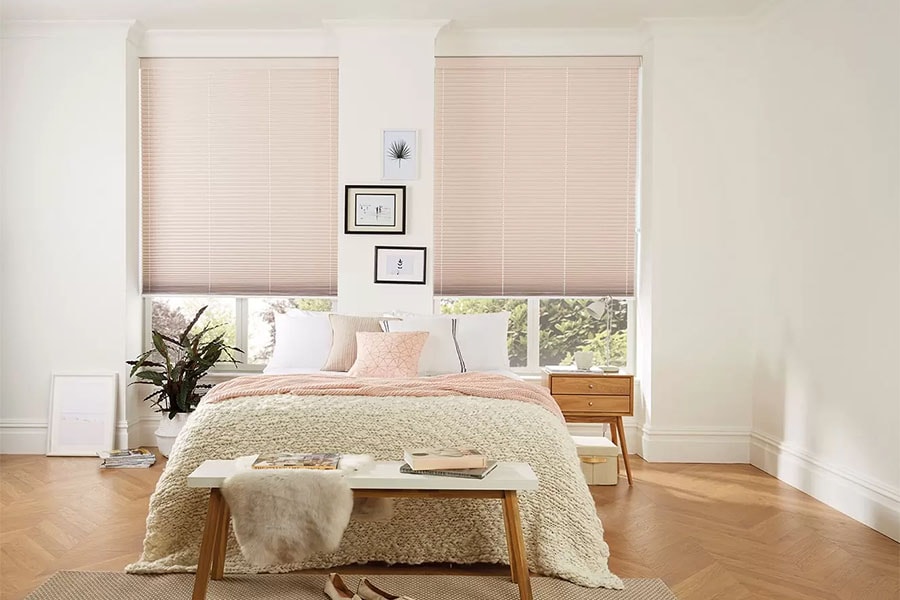Adding blinds to your windows is an important part of your room décor as well as the best way to control light and privacy. This might seem simple, but with so much choice out there and so many companies to choose from, it can be hard to know what you’re looking for, let alone where to start.
Do you know how to measure for blinds? What kind of windows do you have? What is your budget? Do you prioritise insulation or privacy or want both? Our guide helps you answer these questions, so you know what you’re looking for before you start shopping.

It’s essential to accurately measure your windows to ensure a perfect fit for your new blinds. You can do this yourself to get an idea of what type of blind might work best for your window. At Anglian, we professionally measure your windows as part of our custom blinds buying process.
The cost of a blind varies due to many factors, such as type, size, fabric and colour choices. Larger or more elaborate blinds will naturally cost more, and patterned or coloured fabric can also increase the price compared to plain and neutral tones.
Functionality can also affect the price. Consider if you need precise light control in the room where you’re adding blinds, or if a simple up or down blind would work.
Motorisation and smart blinds can also increase costs, so while you might want your blinds to fit into your smart home set up, it is important to remember that.
At Anglian, we offer free installation with our blinds, which can often be an additional cost if you’re not confident with DIY.
Overall, as with any home improvement purchase, you should think about a budget before you start looking.
When it comes to installing your new blind, you can go down the DIY or professional route. It’s often possible to install simpler blinds yourself, but this can involve having the correct tools or lower quality blinds.
Hiring a professional can add extra costs, but it can also mean a quicker and more reliable installation. If you don’t hire a professional and do things DIY, this can add costs down the line if you install the blinds incorrectly. This can result in crooked fits which compromise the effectiveness of the blind, leading to you having to you having to re-fit them, making more mess. With more heavy-duty blinds, if you haven’t installed them properly, they could fall out of the wall, creating mess that you’ve got to fill-in, re-paint and then re-hang with new drill holes. A lot of hassle that you don’t need, and potentially more costs.
There are some companies that offer blinds made-to-measure with you completing the installation. These installations can be very easy, but often the quality of the blind, the materials and the functionality can be lesser than companies which supply and fit for you.
When you buy from Anglian, professional installation of your new blinds is always included at no extra cost.
The classic hand-operated style of blind mechanism. Simply pull the chain in either direction to open or close the blind panels. This can be ideal for a simple roller blind or can be used for twisting the slats on a vertical blind.
A safer option than a side chain, a blinds wand is a thin rod that is attached to the head rail of a set of blinds. This is usually on panel blinds, vertical blinds and venetian blinds. The slats on vertical and venetian blinds are adjusted by twisting the wand, while
Open your blinds with the touch of a button when you choose a motor mechanism to operate them. These can be operated with a remote or some models can be linked to a smart home network for use with a virtual assistant or smartphone.
Going for cordless over a corded blind can bring different pros and cons, including how long they last. A corded blind is raised and lowered by hand using the hanging cord, while a cordless design might use a powered mechanism or direct contact.
A cordless blind with a motor mechanism could last longer as the movement is more controlled when compared with pulling on the cord by hand. However, a blind that’s raised and lowered by direct contact rather than a cord could also be putting more wear and tear on the fabric and the mechanism.
In general, corded and cordless blinds should both work well for many years, so it’s worth considering which will provide the best functionality and safety for your home.
If you have younger children in your home, it’s important to consider the safety of the blinds you choose. Blinds with cords or chains can present a tangle hazard for children, though modern blind cords are designed to break apart under pressure.
Cordless blinds can be a safer option but consider where the blind is going and if cords or chains will be within reach of children or pets.
Another option would be motorised blinds, operated with a remote control, or smart blinds integrated with your smart home system.
Keep your home cooler in the summer with blinds that help to block out the heat.


